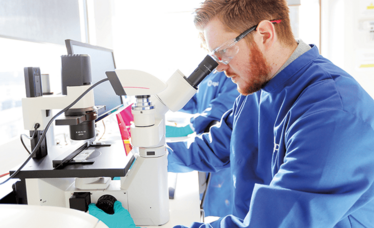
Harnessing Adeno-Associated Viruses
AAV vectors are a promising tool for gene therapy and regenerative medicine, but only if they can be manufactured efficiently

Adeno-associated virus (AAV) is a small, non-enveloped virus with a genome of single-stranded DNA, and for many years nobody paid it much attention because it’s not known to cause disease. But in recent years, researchers have realized that this lack of pathogenicity – in addition to other characteristics – makes AAV vectors perfect for use as a delivery vehicle in gene therapy.
However, manufacturing AAV vectors is no easy task, which is likely to make final therapies very expensive. Hurdles include possible contamination with adenovirus or baculovirus, long lead times for cell line production and virus seed generation, low productivity, and high costs. To tackle the challenges, the UK’s Centre for Process Innovation (CPI) has teamed up with Cobra Biologics, a contract development and manufacturing organization, to develop an industrial manufacturing platform. The project is funded through Innovate UK via their competition for the development of regenerative medicines and cell therapies – and is one of five projects in the area. Juliana Haggerty, public/private program manager at CPI’s National Biologics Manufacturing Centre, sheds more light on AAV vectors and the collaboration.
What is the potential of AAV vectors?
AAV vectors fulfil the basic criteria required of viral vectors in that they can attach to and enter the target cell, and transfer to and be expressed in the nucleus. Their increased use over other delivery methods for gene therapy stems from the fact that they are non-pathogenic, as well as having the ability to transduce non-dividing cells and provide long-term expression of delivered transgenes. The wide variety of serotypes and long-term stable expression also means they offer great potential for gene correction in a broad range of therapeutic areas. Different AAV serotypes can be exploited to specifically target different tissues types, and also help evade pre-existing immunity to the vector, thus expanding the therapeutic application and commercial potential of AAV-based gene therapies.
What progress has been made so far?
In terms of gene delivery, viral vectors are now the preferred vehicle for therapy – and they are being used in around 83 percent of the 483 current on-going gene therapy trials. Within these trials, AAV is the most commonly used vector (41 percent, equating to 103 trials). Several AAV gene therapy products are in late-stage clinical development, and one product is approved in the EU as a therapy for Lipoprotein Lipase deficiency (UniQure’s Glybera). It has been estimated that 20–25 new AAV-based products will start early phase trials each year between 2015 and 2025.
What are the aims of your collaboration?
The project is being led by Cobra, which has a lot of experience in biotech, including viral manufacturing and gene therapies. They were interested in CPI because of our high-throughput process development and analytical capabilities that allow for in-depth characterization. In addition, we have experience in taking processes developed at small scale and translating them to a commercial or industrial environment.
Our aim is to develop a greater understanding of AAV vectors and to develop effective – and scalable – manufacturing methods. In particular, we are looking to develop a toolbox of improved analytical methods that will enable each unit operation to be fully characterized. We’ll be investigating each step of the manufacturing process using design of experiments and high-throughput approaches where possible, with the aim of investigating a range of different manufacturing approaches and technologies.

Over the course of my Biomedical Sciences degree it dawned on me that my goal of becoming a scientist didn’t quite mesh with my lack of affinity for lab work. Thinking on my decision to pursue biology rather than English at age 15 – despite an aptitude for the latter – I realized that science writing was a way to combine what I loved with what I was good at.
From there I set out to gather as much freelancing experience as I could, spending 2 years developing scientific content for International Innovation, before completing an MSc in Science Communication. After gaining invaluable experience in supporting the communications efforts of CERN and IN-PART, I joined Texere – where I am focused on producing consistently engaging, cutting-edge and innovative content for our specialist audiences around the world.



















